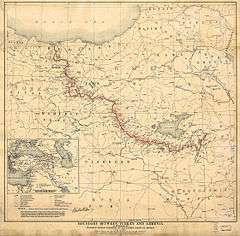Wilsonian Armenia
Wilsonian Armenia (Armenian: Վիլսոնյան Հայաստան) refers to the boundary configuration of the First Republic of Armenia in the Treaty of Sèvres, as drawn by U.S. President Woodrow Wilson's Department of State.[1] The Treaty of Sèvres was a peace treaty that had been drafted and signed between the Western Allied Powers and the defeated government of the Ottoman Empire in August 1920. The treaty was never signed by the United States of America. The treaty was signed but never ratified by the Ottoman Empire.
.svg.png)


The proposed boundaries incorporated the Ottoman vilayets of Erzurum, Bitlis, and Van, which once had Armenian populations of varying sizes. This region was extended to the north, up to the west side of Trabzon to provide the First Republic of Armenia with an outlet to the Black Sea at the port of Trabzon. The proposed state of Pontus was discussed at the Paris Peace Conference of 1919, but the Greek government of Eleftherios Venizelos feared the precarious position of such a state and so it was included instead in the larger proposed state of Wilsonian Armenia.
The United States Senate rejected the mandate for Armenia in 1920. The outbreak of the Turkish War of Independence led to the Ottoman Empire not ratifying the Treaty of Sèvres. Later in that year, the Turkish–Armenian War broke out. Armenia was defeated and signed the Treaty of Alexandropol on November 2, 1920 renouncing its territorial integrity under the Sèvres Treaty. The Treaty of Kars was negotiated between Soviet Russia and Turkey following the annexation of the Democratic Republic of Armenia by the Soviet Army in December 2, 1920, and signed between the Soviet government in Armenia on October 23, 1921. The latter was never accepted, either by the overthrown Armenian government nor later by the Republic of Armenia. The government of Soviet Russia separately negotiated a similar border between what it considered its territory of Armenia and Turkey in the Treaty of Moscow (1921).
The final Turkish and Armenian borders were internationally agreed upon in the Treaty of Lausanne in 1923 which replaced the generally unratified and unimplemented Sèvres Treaty.
Negotiations
During the Conference of London, David Lloyd George encouraged Wilson to accept a mandate for Anatolia, and particularly, with the support of the Armenian diaspora, for the provinces claimed by the occupied Turkish Armenia. Wilson sent the King-Crane Commission and General James Harbord to the region to study the claims made by the Armenian national movement, and to determine if these claims were compatible with Wilson's Fourteen Points. The 12th point was:
"The Turkish portion of the present Ottoman Empire should be assured a secure sovereignty, but the other nationalities which are now under Turkish rule should be assured an undoubted security of life and an absolutely unmolested opportunity of autonomous development, and the Dardanelles should be permanently opened as a free passage to the ships and commerce of all nations under international guarantees."
The King-Crane Commission tackled the issue of whether there should be an Armenian state, and whether or not this state should be created under a US mandate and concluded that there should be one. It has been noted that the arguments the Commission proposed to justify the creation of an Armenian state were similar to later arguments for the existence of Israel after World War II. Harbord recommended against dividing the territories inhabited by Armenians, in order to prevent potential problems such as intercommunal wars. Harbord's report stated that "the temptation to reprisals for past wrongs" would make it extremely difficult to maintain peace in the region.
The King-Crane Commission noted that the Armenians had suffered a traumatic experience, that they couldn't trust the Ottoman Empire to respect their rights any more, and that the Armenians were "a people." The Commission therefore recommended that the hard-won Armenian independence established during the Caucasus Campaign should be respected by the international community and insured by the Allies.
Armenian arguments
The Armenian Revolutionary Federation (ARF), using their position of leaders of the Armenian national movement, claimed that this region should not be part of the Ottoman Empire based on their assertion that Armenians had the capability to build a nation. Armenians had de facto control over a region surrounding the Van Province of the Ottoman Empire for nearly 3 years (1915-1918). The ARF stated that it was natural to annex this region to the newly established First Republic of Armenia (1918-1920), the first modern Armenian republic created after the collapse of the Russian Empire.
Another argument developed during this period was that the population was becoming increasingly more Armenian, and therefore Armenians were not a minority but a plurality; moving the displaced Armenians to this area should be considered as an option. In 1917, some 150,000 Armenians relocated to the provinces of Erzurum, Bitlis, Muş, and Van.[2] The Armenians had already begun building their houses and creating their farmlands. In 1917, the provincial governor Aram Manukian stated that a new autonomous state in the region should be founded, under Russia or the Ottoman Empire. Armen Garo (Karekin Pastermajian) and other spokesmen proposed to have Armenian soldiers in Europe transfer to the Caucasus front for the protection and stability of the new establishment. Armenian soldiers began to create a protective line between the Ottoman Army and Armenian front.
Aftermath
In the aftermath of the King-Crane Commissions, events on the ground took their own course. President Wilson asked the United States Congress for the authority to establish a mandate for Armenia on May 24, 1920. The United States Senate rejected his request by a vote of 52 to 23 on June 1, 1920. In September 1920, the Turkish–Armenian War broke out. The First Republic of Armenia was defeated in November 1920 and signed the Treaty of Alexandropol under which it renounced the Treaty of Sèvres along with various territorial claims to "Western Armenia". The government of Armenia was subsequently overthrown. The new Armenian government signed the Treaty of Kars, which reaffirmed the previous Armenian concessions to Turkey and determined the modern-day borders between the two countries.
In late 1922, the various international parties negotiated the Treaty of Lausanne as a replacement for the Treaty of Sèvres. Given previous Turkish-Armenian treaties and the views of the then-current Soviet Armenian government, the issue of Armenian claims to "Western Armenia" was dropped.
After World War II, the Soviet Union attempted to annul the Treaty of Kars and regain the lands ceded to Turkey. The Soviet claims were backed by much of the international Armenian diaspora, as well as the Armenian Revolutionary Federation.[3] Armenian leaders attempted to gather British and American support for the reclamation of eastern Anatolia from Turkey, but Winston Churchill objected to the Soviet and Armenian territorial claims. Likewise, the United States State Department backed Turkey as well, saying, as it had since 1934, that its previous support for Wilsonian Armenia had since expired.[4] The Soviet Union dropped its claims against Turkey after Stalin's death in 1953.[5]
Modern times
Today, as a continuation of the initial goal, the creation of an independent and united Armenia consisting of all territories designated as Wilsonian Armenia by the Treaty of Sèvres is a stated aim of the Armenian Revolutionary Federation, regardless of the United States's official ending of support for the idea in 1934[4] and the fact that these territories are now inhabited mainly by ethnic Kurds and Turks. The Armenian Revolutionary Federation, as well as the Social Democrat Hunchakian Party and the Armenian Democratic Liberal Party in a joint statement on the occasion of the 100th anniversary of the Treaty of Sevres, stated that it still needs to be implemented, and that it is the only treaty signed by Turkey and the Republic of Armenia, by the free will of the Armenian side.[6] On 10 July 2020 the President of Armenia Armen Sargsyan stated that "The Treaty of Sèvres even today remains an essential document for the right of the Armenian people to achieve a fair resolution of the Armenian issue" and that it is "a legal, interstate agreement which is de facto still in force".[7]
Armenian Genocide historian Vahakn Dadrian argued that, though it began as an effort to improve the lot of Armenians, the Treaty of Sèvres served mainly to compound the misfortunes of Armenians. He wrote that:"However long overdue and deserved its terms might have seemed to the Armenians, its promise of restoring to the Armenians a large chunk of historic Armenia fueled extravagant Armenian hopes and irredentist aspirations."[8] Genesis of the Sèvres Treaty also coincided with the definitive defeat of the Damat Ferit's Cabinet in Istanbul which had initiated the prosecution against the authors of the genocide. From that period on court martial proceedings slackened and gradually disappeared.[8]
See also
Notes
- Hovannisian, Richard G. (1996). The Republic of Armenia, Vol. IV: Between Crescent and Sickle, Partition and Sovietization. Berkeley, California: University of California Press. pp. 40–44. ISBN 0-520-08804-2.
- Hovannisian Richard G. The Armenian People from Ancient to Modern Times: Vol. II: Foreign Domination to Statehood: The Fifteenth Century to the Twentieth Century. New York: St Martin's Press, and London: Macmillan, 1997
- Richard G. Hovannisian The Armenian People from Ancient to Modern Times: Foreign dominion to statehood: the fifteenth century to the twentieth century. Palgrave Macmillan, 2004. P. 417
- Suny, Ronald Grigor (1993). Looking Toward Ararat: Armenia in Modern History. Indiana University Press. pp. 169, 175–176.
- Ro'i, Yaacov (1974). From Encroachment to Involvement: A Documentary Study of Soviet Policy in the Middle East, 1945-1973. Transaction Publisher. pp. 106–107.
- Armenian traditional political parties issue joint statement on Treaty of Sevres, News.am
- President Armen Sarkissian: “The Treaty of Sèvres even today remains an essential document for the right of the Armenian people to achieve a fair resolution of the Armenian issue”, President.am
- Vahakn N. Dadrian The History of the Armenian Genocide: Ethnic Conflict from the Balkans to Anatolia to the Caucasus, p. 359
